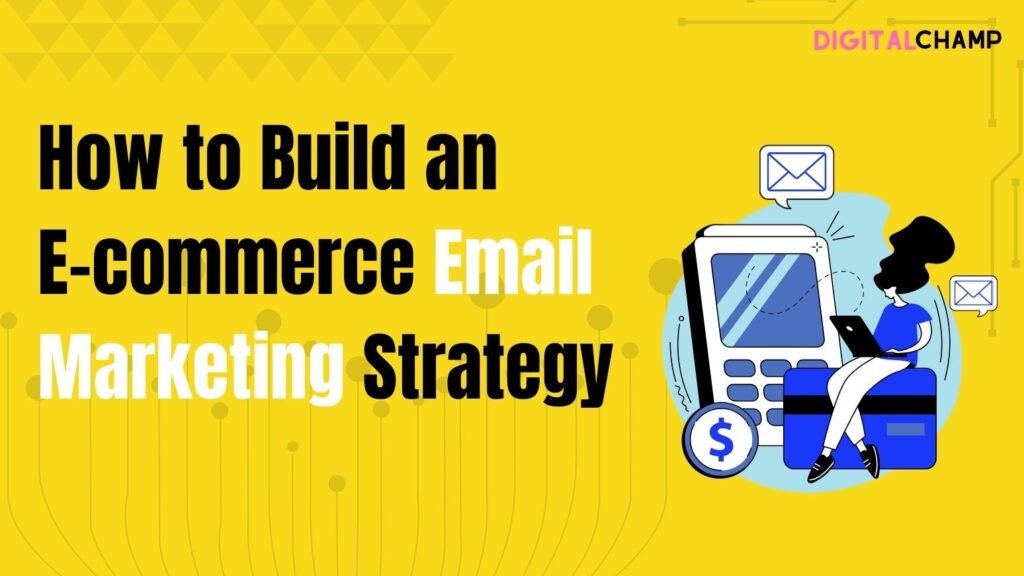As per Hubspot, more than four billion email users go live every day. Since the dawn of the internet, emails have been regarded as the primary form of professional communication between people and businesses. Over the years, devices have gained the ability to send and receive emails, giving further accessibility to users. Businesses, especially the e-commerce kind, leverage emails to a great extent. If you’re a new e-commerce business that has gone live recently, it is high time to consider building an e-commerce email marketing strategy.
Today’s blog will take a closer look at the way email marketing should be done, the types of emails your business can utilize, and how to build an e-commerce email marketing strategy. Irrespective of the geography you’re in, starting an e-commerce email marketing campaign is crucial and we’ll help you build an understanding that helps your business.
What is email marketing?
Before getting into the intricacies surrounding building an e-commerce email marketing strategy, let’s first understand what email marketing really is. Simply put, email marketing is the practice of reaching out to people and businesses for the promotion of your products and services. Email marketing allows you to highlight the specifics of your business’s USP (Unique Selling Point), enabling people to develop an interest and eventually convert into profitable customers.
The objective of email marketing is to showcase the latest happenings in your products and services lineup. Things such as the latest updates to a software application, the addition of new features to an old physical product, changes in terms of usage, or issuing a general notice for a change in services are all part of email marketing campaigns.
Email marketing can be used for many purposes. It all boils down to how you’re going to use it. These days, businesses use customizable emails to target their audience. That’s because people now appreciate the personalization elements more than the generalized ones. Things such as mentioning the recipient’s name, interests, or even general location help brands establish a positive presence among the people.
A good email marketing campaign fetches great ROI (Return on Investment). If done correctly, it can boost conversions, generate leads, and even sell products for your brand. Marketers these days prefer sending two to three emails daily to increase the chances of conversions.
Gain the edge over your competition across channels like YouTube, Instagram and TikTok with our comprehensive Paid Media Services today.
Benefits of email marketing
Now that we’ve discussed what email marketing is all about let’s discuss the benefits of doing email marketing:
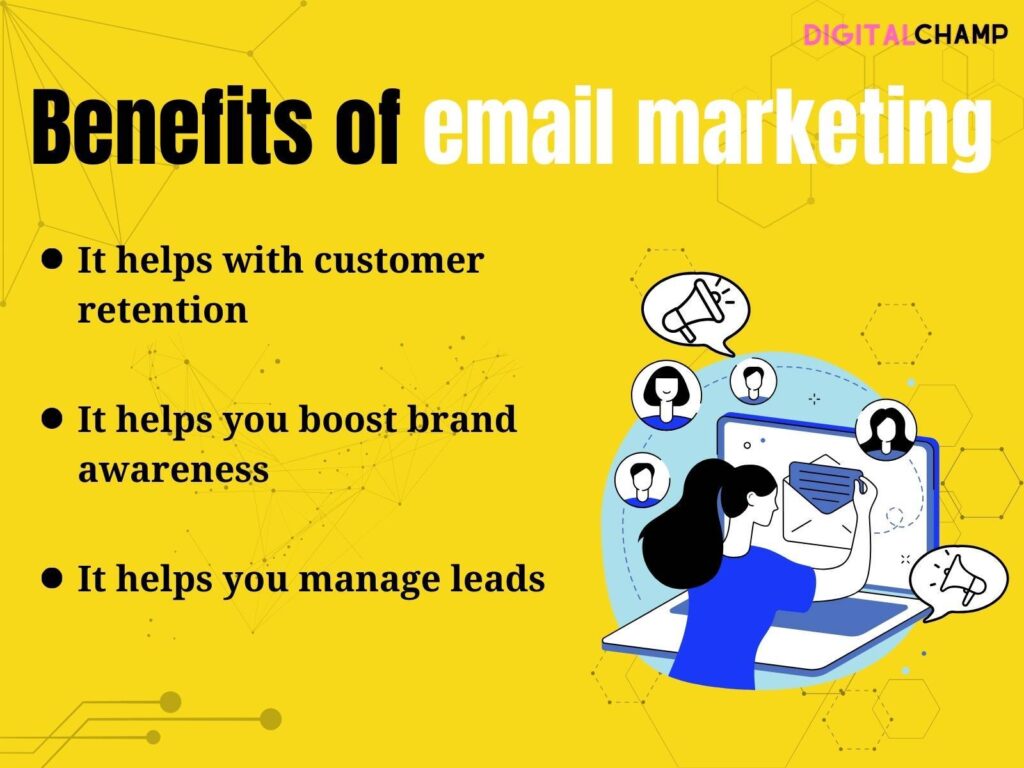
Email marketing drives sales
It’s a no-brainer in today’s world that a good e-commerce email marketing strategy fetches conversions that eventually lead to sales. You can use a well-structured email for multiple occasions, some of them can be listed as follows:
- Offers on a product’s launch
- Offers on a special occasion like a national holiday or a festival
- Setting up CTAs to access abandoned carts for your online store
A well-crafted email with elements such as a strong CTA and links can be the difference between a fruitful conversion and a spam. It’s best to shape the content to fit the former category more. The average email open rate for an email marketing campaign is 36.5%.
Emails help with customer retention
It is cheaper to retain an existing customer than to entice a new one. A good e-commerce email marketing strategy includes elements that aid businesses to retain customers. About 61% of customers spend an average of eight seconds per email. By sending dedicated emails to your existing customers, you can retain a good chunk of your customers and reduce the churn rate.
This allows your business to grow regardless of the fluctuating margin of conversions. If existing customers find value in the content of your emails, chances are that they’ll begin spreading the good word of your business to their friends.
Emails help you boost brand awareness
If you happen to have a creative subject line for your email, then you can garner the reader’s attention quickly. A catchy subject line also stays longer in a customer’s memory than a regular one. There are instances in which a customer might have taken an interest in a subject line but may have closed the email accidentally. A good subject line, in this case, will drive the customer back to the email at some point and will eventually register its presence.
While such cases are less frequent, they do happen, which is why you shouldn’t take email marketing lightly. Emails can aid you in boosting brand awareness just like any other piece of media shared via a different channel.
Emails help you manage leads
The lead generation aspect doesn’t originate from emails but ends on them for sure. Here’s how you can use emails to manage leads for your business:
- You incentivize the visitor’s session on your website with value-driven takeaways like free data reports, case studies, whitepapers, and newsletters. This simple act gives the user a chance to interact with the free asset you’re providing. However, to download the file, you ask the user for simple information such as their name and email address. That’s how you gain the information capable of becoming a lead.
- Now that you have the names and email addresses, you can start sending more content assets such as event updates, notices on offers and sales, and newsletters capturing the happenings of the month or weeks. This process happens via emails and personalized messages for platforms like WhatsApp and Instagram. However, emails form the primary method of communication after generating a lead.
- The next step involves enticing the lead with information over a span of time with valuable content pieces and driving them to make a decision. At the end of this journey, give the lead a CTA that best fits their current situation; keep it simple. If done correctly, the lead will then convert into a customer, and you’ll have a layout that is successful and boosts ROI.
Types of marketing emails
We’re closer to understanding how to build an e-commerce email marketing strategy, but we need to understand the various types of emails that you can utilize for your campaigns. Let’s take a look at some of the most prominent types of emails that are used by businesses across the globe:
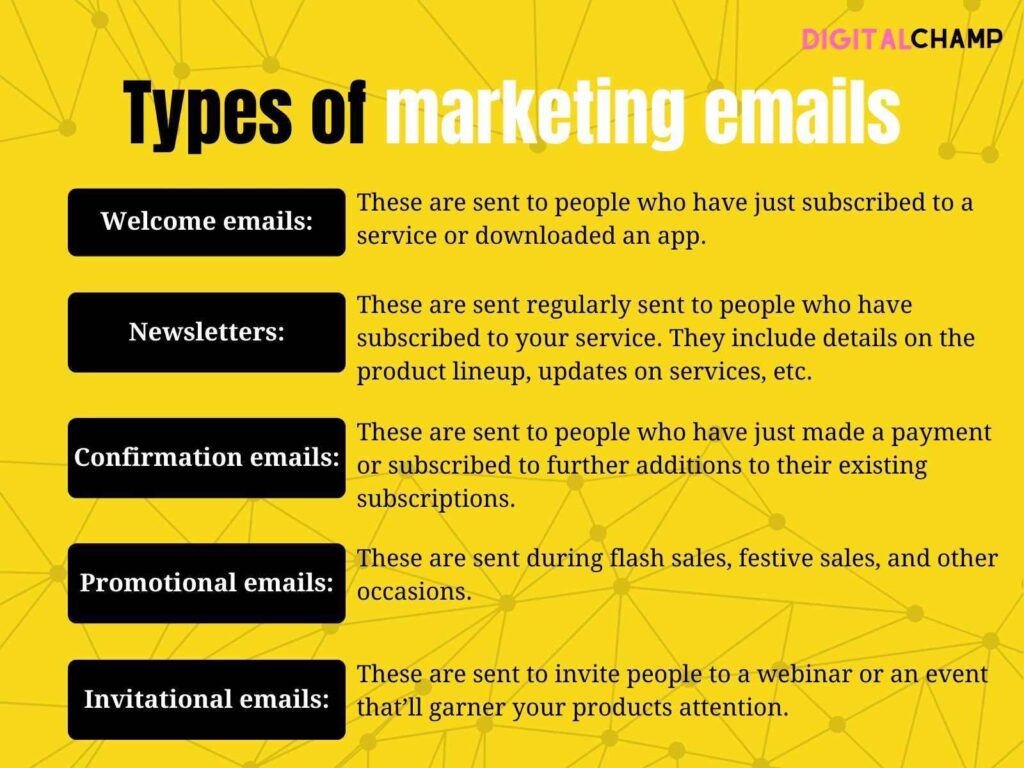
- Welcome emails: As the name suggests, welcome emails are sent to people who are welcomed into an ecosystem, a mobile application, a service subscription, etc. As a seller, you can use a welcoming email to simply greet first-time customers by congratulating them on registering themselves on your e-commerce website or making their first purchase.
- Newsletters: Newsletters are documents that contain information on your brand, the product, or any latest developments that have occurred over a period of time. While the common practice is to attach the newsletter to your email as a downloadable file, you can also present it in its entirety within the email body.
- Confirmation emails: Confirmation emails do just that, they give the user a confirmation on an action they’ve just performed. Actions such as registering for a plan or logging into a portal require authentication, and that’s what such emails provide.
- Promotional emails: Promotional emails are used extensively during flash sales, opening ceremonies of businesses and on holidays. These emails contain offers such as sales, promo codes, time trials for services, vouchers, and more.
- Invitational emails: Invitational emails are simple invitations for events such as the opening of a store, the launch of a new product, an invitation to a webinar, and more. These emails are used to build a strong first impression on the customers and establish your brand as a reliable name in the market.
Run marketing campaigns with techniques that boost ROI. Collaborate with the best team of marketing professionals in Australia and Run Your First Campaign today.
How to build an e-commerce email marketing strategy
Every email marketing campaign requires a well-thought-out strategy. While building a strategy isn’t an ordeal, implementing it might be. Here’s what you need to know to build an e-commerce email marketing strategy in 2024:
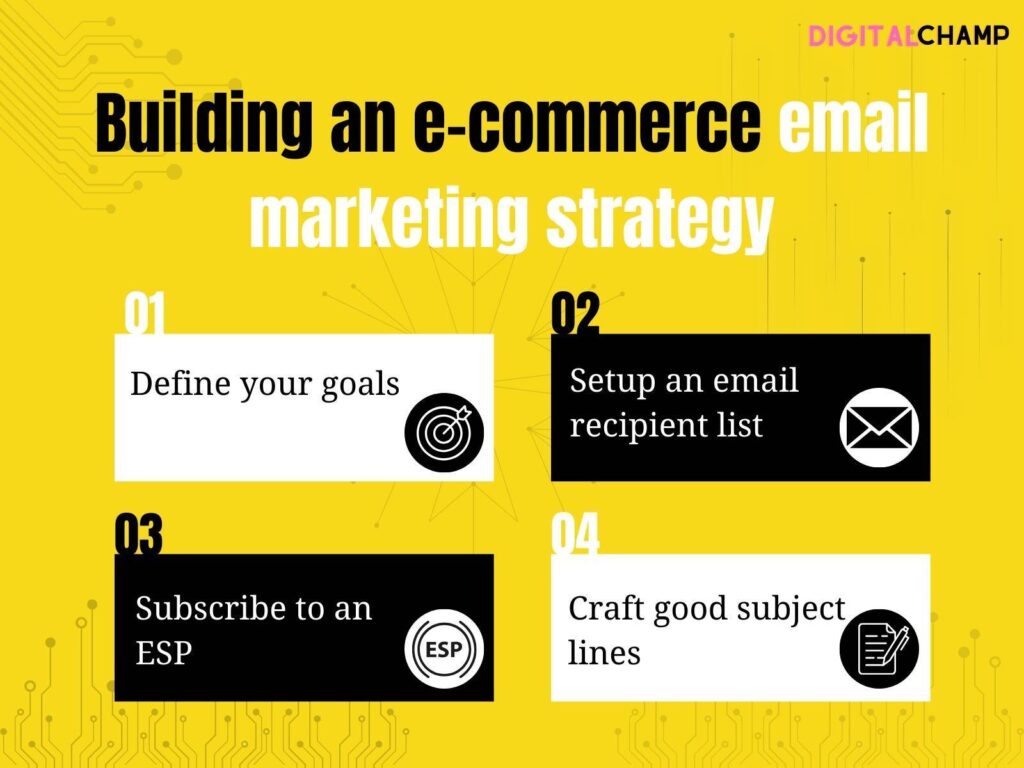
Set your goals
The first step towards setting up a viable e-commerce email marketing strategy is understanding and defining your goals. Ask yourself why you need an email marketing campaign and what you intend to achieve from it. By setting a goal, you’ll be able to list the pain points your marketing campaign aims to cater to.
Set up an email recipient list
Another crucial aspect of building an e-commerce email marketing strategy is building an email recipient list. To build an email recipient list, you’ll have to follow the same steps as mentioned in the lead generation section above. However, let’s take a glance at it again:
- Collect information such as names of customers and their email IDs from your e-commerce website, application, exit intent forms, or portal.
- Once you’ve collected the names and email addresses of your website’s visitors, you should then proceed towards segregating them into clusters containing other information such as geographies, purchase history, and behavior.
Get a good ESP
An ESP refers to an Email Service Provider. It is a platform that helps you design and run an email marketing campaign. But why choose an ESP when you have your conventional email IDs from Google, Yahoo, and others?
Well, that’s because of a few reasons. Here’s why you need an ESP for running an email marketing campaign:
- An ESP allows you to send emails in bulk. Regular email services can do the same, but they’ll end up landing in the receiver’s spam folder.
- An ESP also aids the user by helping them create different campaigns for different groups, something that regular email services cannot provide.
- An ESP also provides automation tools for email scheduling and bulk sending.
Choosing a good ESP for your e-commerce email marketing campaign is crucial. Here’s what you need to look for in a good ESP:
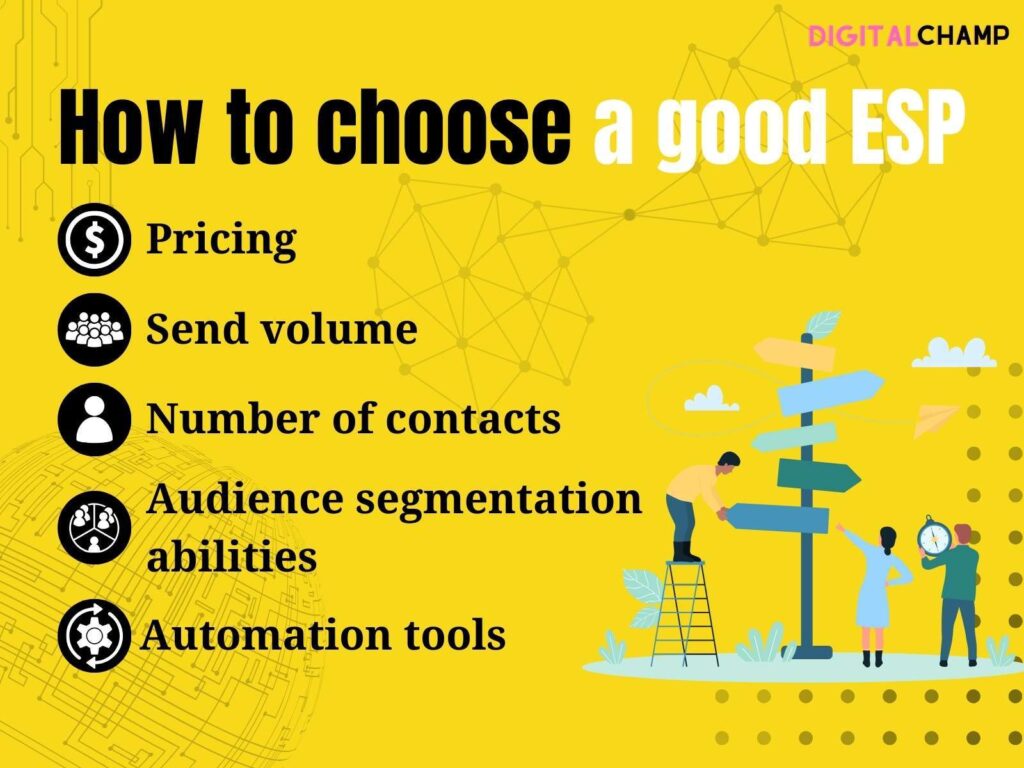
- Pricing: Check whether the ESP falls into your marketing budget or not. You don’t necessarily need to find the most expensive ESP for your job. All you need to look at is the list of features that different ESPs provide.
- Send volume: Since you’ll be sending emails in bulk, check whether the send volume matches your requirements or not. It is preferred to have a send volume that is slightly higher than your requirements, as you can run additional campaigns if required.
- Number of contacts: Ensure that your ESP can accommodate the right number of recipients for a campaign. Look for an ESP with a number slightly higher than what you require.
- Audience segmentation: A good ESP should be able to segregate your audience into segments such as demographics, geographies, interests, hobbies, previous purchases, and general buying behavior. The more nuanced the audience segmentation is, the more accurate your email marketing campaigns will be.
- Automation: Check whether your ESP has provisions for automation tools, such as a scheduled sending sequence, an auto replying sequence, and more. It’ll help you focus on other matters.
Discover the 7 Best Ways to Generate Quality Leads in 2024 for your brand. Combine the best of lead generation with the marketing technique of your choice.
Write captivating subject lines
The first thing a customer sees when accessing their inbox is the subject line of your email. Make sure to include the primary terms that reflect the intent of your campaign while also predicting the customer’s needs and wants.
A captivating subject line is the difference between a successful and a failed campaign. While your subject lines should be creative, they should also be simple enough for the customer to understand. The first three to five seconds are the most crucial for a conversion, so write subject lines that grab the attention of the reader while giving them value.
To sum it up
We check our inbox twice a day, almost daily. Everyone has grown accustomed to this lifestyle and brands know this as well. As an e-commerce business in today’s rapidly evolving digital world, it is imperative that you equip yourself with the latest e-commerce email marketing strategy to get the best ROI. We hope that you’ve read about and discovered the value of an email marketing strategy through our blog. Until next time, happy selling!

